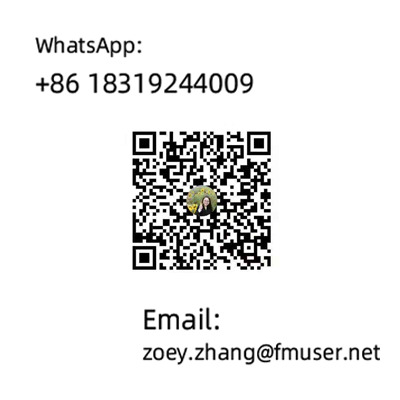Products Category
- FM Transmitter
- 0-50w 50w-1000w 2kw-10kw 10kw+
- TV Transmitter
- 0-50w 50-1kw 2kw-10kw
- FM Antenna
- TV Antenna
- Antenna Accessory
- Cable Connector Power Splitter Dummy Load
- RF Transistor
- Power Supply
- Audio Equipments
- DTV Front End Equipment
- Link System
- STL system Microwave Link system
- FM Radio
- Power Meter
- Other Products
- Special for Coronavirus
Products Tags
Fmuser Sites
- es.fmuser.net
- it.fmuser.net
- fr.fmuser.net
- de.fmuser.net
- af.fmuser.net ->Afrikaans
- sq.fmuser.net ->Albanian
- ar.fmuser.net ->Arabic
- hy.fmuser.net ->Armenian
- az.fmuser.net ->Azerbaijani
- eu.fmuser.net ->Basque
- be.fmuser.net ->Belarusian
- bg.fmuser.net ->Bulgarian
- ca.fmuser.net ->Catalan
- zh-CN.fmuser.net ->Chinese (Simplified)
- zh-TW.fmuser.net ->Chinese (Traditional)
- hr.fmuser.net ->Croatian
- cs.fmuser.net ->Czech
- da.fmuser.net ->Danish
- nl.fmuser.net ->Dutch
- et.fmuser.net ->Estonian
- tl.fmuser.net ->Filipino
- fi.fmuser.net ->Finnish
- fr.fmuser.net ->French
- gl.fmuser.net ->Galician
- ka.fmuser.net ->Georgian
- de.fmuser.net ->German
- el.fmuser.net ->Greek
- ht.fmuser.net ->Haitian Creole
- iw.fmuser.net ->Hebrew
- hi.fmuser.net ->Hindi
- hu.fmuser.net ->Hungarian
- is.fmuser.net ->Icelandic
- id.fmuser.net ->Indonesian
- ga.fmuser.net ->Irish
- it.fmuser.net ->Italian
- ja.fmuser.net ->Japanese
- ko.fmuser.net ->Korean
- lv.fmuser.net ->Latvian
- lt.fmuser.net ->Lithuanian
- mk.fmuser.net ->Macedonian
- ms.fmuser.net ->Malay
- mt.fmuser.net ->Maltese
- no.fmuser.net ->Norwegian
- fa.fmuser.net ->Persian
- pl.fmuser.net ->Polish
- pt.fmuser.net ->Portuguese
- ro.fmuser.net ->Romanian
- ru.fmuser.net ->Russian
- sr.fmuser.net ->Serbian
- sk.fmuser.net ->Slovak
- sl.fmuser.net ->Slovenian
- es.fmuser.net ->Spanish
- sw.fmuser.net ->Swahili
- sv.fmuser.net ->Swedish
- th.fmuser.net ->Thai
- tr.fmuser.net ->Turkish
- uk.fmuser.net ->Ukrainian
- ur.fmuser.net ->Urdu
- vi.fmuser.net ->Vietnamese
- cy.fmuser.net ->Welsh
- yi.fmuser.net ->Yiddish
What is Modulation?
This page explains what is the function of modulation and covers its types.
We will discuss here analog and digital modulation types. Modulation is a term widely used in telecommunication or wireless networks. Modulation basically is used to convert information (digital bit stream or analog audio signal) in the form that can be physically transmitted over the air or cable. Information is referred as baseband or modulating signal. The waveform which is used to convert the information in the physically transmitted form is called carrier. The device which performs modulation operation is called modulator and the resulting waveform or output of modulator is called as modulated signal. The device which performs inverse of modulation is called demodulator and the operation is named as demodulation. The device which does both modulation and demodulation is called MODEM. Modulation can be applied on Direct current, alternating current and optical signal. Earlier days Morse code has been used in telegraphy which was used as modulation technique to convert information into the form that can be transmitted over telegraph line. It is used to convert information to binary form i.e. ON and OFF forms. This is very popular in amateur radio.
The live example of modulation and demodulation process is in our home when we use internet. For Internet we use MODEM which can housed in USB Dongle, Mobile, IPAD, laptop etc.
In MODEM, modulator converts digital information into analog audio tones (or Radio frequency signal) and demodulator does reverse.
To know what modulation is let us understand two major categories of modulation. Analog modulation and digital modulation, the same is depicted in following figure. AM has been shown for analog modulation and ASK for digital modulation. The fundamental difference is, baseband input signal for Analog modulation is analog and for digital modulation it is digital. The carrier is analog for both the cases.


Analog modulations techniques are as follows:
AM: The carrier amplitude is changed as per analog baseband signal.
FM: The carrier frequency is changed as per analog baseband signal.
PM: The carrier phase is changed as per analog baseband signal.
Applications: Radio and television broadcast stations use AM and FM form of modulation. Some employ Single Side Band Modulation.
Few of digital modulation techniques are as follows:
ASK- It uses a finite number of amplitudes. Widely used in optical fiber where in for LED transmitters binary 1 is by a pulse of light and binary 0 by the absence of light. In some other applications different amplitudes i.e. lower and higher amplitudes are used to represent binary 1 and binary 0.
FSK- It uses a finite number of frequencies. F1 and F2 are used to represent binary 1 and binary 0.
PSK- It uses a finite number of phases. P1 and P2 are used to represent binary 1 and binary 0.
The most complex digital modulation techniques used now-a-days are BPSK, QPSK and QAM, widely employed in radio and microwave communications for cellular and satellite communication.
Maybe you will like:
What is Modulation? Different Types of Modulation Techniques
What is FM ( Frequency Modulation)?
What is the modulation characteristics of FM broadcasting
What is QAM - Quadrature Amplitude Modulation





